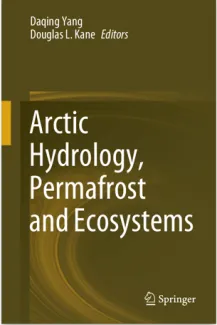A recently published book focusing on high- latitudes hydrology, permafrost, and ecosystems features contributions from NGEE -Arctic scientists (Fig. 8). The book discusses fundamental features, processes, interactions, and feedbacks in Arctic systems, as well as discussion of critical knowledge gaps. The book is divided into five 5 parts, spanning thirty 30 chapters, and explores system processes and components from both the local- to global -scales.
Chapter 7 of the book, “Historical extremes in Arctic Rivers and Regions: Historical variability and future perspectives,” is authored by Rajesh Shrestha (Environment and Climate Change Canada, [ECCC]), NGEE Arctic researcher Katrina E. Bennett (LANLLos Alamos National Laboratory), Daniel L. Peters (ECCC), and Daqing Yang (ECCC). The chapter details different types of hydrologic extremes in Arctic rivers, including river-ice jam spring floods, snowmelt-driven spring peak flows, rainfall-driven summer peak flows, and winter low flows. The introduction to the chapter gives provides an overview of the major processes that contribute to Arctic extreme streamflow, and following thisas well as, historical changes and trends in extremes reviewings previous work on Pan-Arctic river systems. Bennett’s section of the paper (7.2.5) describes a case study of nonstationary frequency generalized extreme value (GEV) analysis of maximum streamflow within eight Alaskan river basins. The results indicate that the systems undergoing the greatest changes in extreme maximum streamflow are dominated by high snowpack and glaciers, such as the Chena and Talkeetna Rivers. Systems that are not changing, such as the Yukon River, may be experiencing multiple effects that result in opposing shifts within their systems, such as earlier snowmelt versus declining precipitation.
Bob Bolton (University of Alaska FairbanksUAF), with Jessie Young-Robertson (University of Alaska FairbanksUAF) and Ryan Toohey (USGS), contributed a chapter titled “Northern Ecohydrology of Interior Alaska Subarctic” on boreal forest ecohydrologic processes in the sub-arctic, discontinuous permafrost ecosystem of Interior Alaska. Here, the authors explored the processes along the soil-plant-atmosphere continuum. The presence or absence of permafrost determines whether ecological or hydrological processes drive water cycling. In areas underlain by permafrost, the limited soil storage capacity dominates hydrologic processes as the dominant coniferous vegetation has low water use and a low storage capacity. In non-permafrosted areas, hydrologic processes are dominated by ecologic processes due to high water use rates and water storage ability of the dominant deciduous vegetation. The field of “northern ecohydrology” is still in its infancy and a number of knowledge gaps still remain, including the role of tree water storage in non-permafrost areas, the degree to which plants control evapotranspiration (ET) potential changes in soil storage capacity due to a diminished permafrost regime, and the degree to which the sub-arctic experiences drought. Filling these knowledge gaps will help us researchers understand the consequences of shifting ecohydrologic dynamics as permafrost degrades and deciduous vegetation become more dominant in this important ecosystem
For more information, please contact:
Bob Bolton
boltonwr@ornl.govKatrina Bennett
kbennett@lanl.gov

